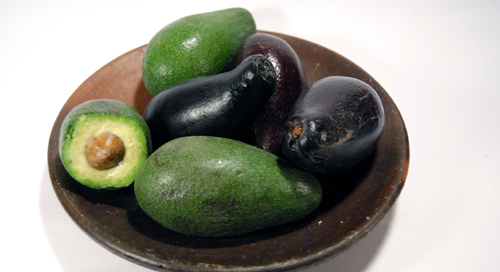
Continuing our odyssey into the world of avocados, below is a selection of the most common varieties found in Chile. Researching a little more, I discovered that you can find many of these varieties in the States now, particularly in California, and even through special online retailers that will deliver them perfectly ripe to your doorstep like Will’s Avocados. If you are wondering what to do with all these avocados, check out sites like Allrecipes.com for tons of ideas and recipes in addition to the ones listed below. Avocados are full of healthy fat and vitamins and very good for you. However, like olive oil, keep in min they are fat so don’t go to town and employ the “one a day” mentality. A quarter or half of one will suffice.
Varieties
Hass:
This is the Granddaddy of all avocados worldwide. Known for its oval shape, smooth purplish-black skin, and easy peeling, the flesh of this avocado can only be described as buttery, rich-tasting and creamy.
Season: Summer time and early fall in Chile (Jan-April) is prime time for this avocado when the prices drop and you can consume it in copious amounts. However, given the length of the Central Valley, during the fall and winter months, some avocados hail from the Northern Valleys near La Serena. Careful though, in Chile there is “old Hass” and “new Hass”, referring to a frost that severely damaged the trees. The old Hass is the way to go—the new ones are watery with zero flavor.
Uses: Umm…everything? Chop it up on a salad, mash into guacamole, Spreads it on toast, slice it down as an accompaniment. This is also the avocado used to make Avocado Oil, a delicious oil made by companies like Terramater. They also sell the oil in stores like Whole Foods. The nutty flavor will give some instant pizazz to a seared flank steak or any vinaigrette.
Lamb Hass:
Similar to the Hass variety, the shape here varies slightly. I could never quite figure out why some of the Hass avocados were rounder-shaped and much larger. Well now I know—it is a new variety! Looking closely, there are some differences. The skin is more pebbly and closer to black. The size is much larger, up to 16oz/440g per avocado in some cases!
Season: Also a sun variety (read: summer), this starts to flood the markets around Christmas and extends until April. The peak is in February when the avocados literally look like softballs.
Uses: Exactly the same as the regular Hass, although truth be told, given the amount of flesh with this avocado, I normally use it to make a delicious chilled soup with chicken stock and yogurt, topped with crunchy goat cheese toasts and merkén.
Edranol:
Semi-rough with a medium-thick skin, this avocado peels perfectly. The skin is dark green with little bumps and reveals a buttery yellow flesh. I love the flavor–soft and creamy with a nutty overtone.
Season: This variety is cultivated near the coast and is particularly frost resistant, which means it is grown in the winter months from June to September.
Uses: This is definitely my favorite avocado in the winter. Although not as heavy or dense as the Hass, I find it is a wonderful substitute and probably more flavorful. I love this with a wintery salad like endives, blue cheese, candied walnuts, and slices of avocado.
Fuerte:
This pear-shaped avocado with thin, green skin is another, economical quinessential winter variety. The flesh is yellowish-green and obviously more watery due to the lower fat content. I also find the taste is “greener” and lean than other avocados.
Season: Late fall through Spring, which translates to May-September in Chile. The only strike against this avocado is its high sensitivity to bruising and short duration. Be ultra careful toting these home from the market and at the first sign of ripeness, eat them! These guys are for quick rotation, which usually isn’t a problem.
Uses: I use this interchangeably for the Hass avocado. However, if making guacamole, since the avocado has a higher water content, you may need to add a little mayo to achieve the right creaminess and texture. This also goes brillantly with a tomato-mango-avocado salad. I got a little creative last time and whipped up a curried vinagrette.
Bacon:
An oval-shaped cousin of the Fuerte, the flesh is more yellow in color, the texture slightly firmer (although still “mashable”) and the flavor is very light. If you are looking for a “low fat” avocado, this is your best bet.
Season: Appears at the onset of winter (June) and extending into the spring (September).
Uses: since the flavor is lighter and less filling, this is a good avocado to make the palta reina, meaning “Queen Avocado” in Spanish. Basically, the avocado is peeled and pitted and then filled with tuna or shrimp salad and served as an elegant appetizer or light lunch with lettuce leaves.
Ester:
My casero Gabriel turned me on to this avocado—it’s his favorite. I didn’t understand all the fuss until I tried. The flesh of the Ester is more Parsley-green colored and does not have the nutty flavor of the Hass. It has a very pure essence of avocado. Here it transcends from being a fruit taste to something more green. The smooth texture of this avocado too is addictive.
Season: Late summer into early fall. However, I would say the month for this avocado in Chile is really only May (probably October in California). Eat up in that window!
Uses: Given the short season, I am not really into adulterating this so I eat it pretty simply. Mashed on toast with sea salt for breakfast; sliced in my favorite salad, hearts of palm-tomato-avocado; or on top of a roasted chicken sandwich with a little cilantro.
Florencia:
Long-necked with a bell-like bottom, this avocado has purple skin and is very sweet. Yes, a sweet avocado. The flesh is soft, perfumed, and has for me, a feminine quality about it.
Season: The window of this avocado, which is not cultivated in great numbers in Chile is from June-August.
Uses: I ate this in salad and it was too sweet. However, I prepared a couple smoothies and milkshake with this with great results. Option 1: blend avocado with vanilla yogurt and a touch of Honey and a fistful of ice. Option 2: Blend the avocado flesh with ice and condensed milk for a milkshake. Unusual and refreshing (they also love these in Brazil and Vietnam), it was more like an avocado dessert. Although I have not tried yet, I am willing to bet you can make ice cream out of this.
Negra de la Cruz:
One of the most popular varieties in Chile during the cooler months of the year, these shiny, black-skinned avocados are one of the most economical avocados when in season, rarely surpasssing US$2/kilo (2.2 pounds). The pit is large with this avocado and I find it is not easy to peel with sticky, thin skin. You need to Peel it first using a knife. Trying to scoop out the flesh will lead to much undo frustration. This avocado is a little more fibrous with a mild flavor.
Uses: Chilean adore this avocado in classic salads like celery-avocado, with celery cut into thin slices tossed with lemon juice, the avocado, and sea salt. If you decide to mash it, make sure to pick out the strings or risk using them as dental floss.












